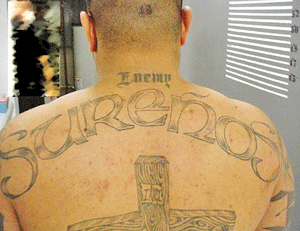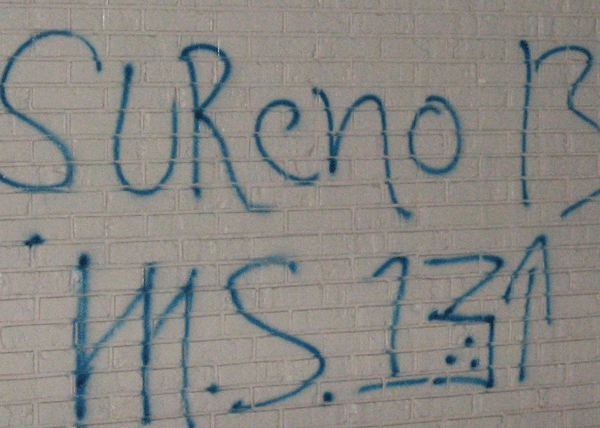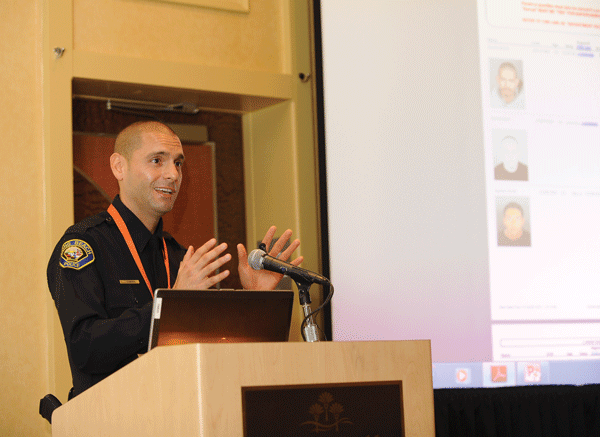IT innovation helps fight gangs

All across Australia, state governments have either introduced or are introducing laws to prevent criminal association. These have been popularly dubbed the Anti-Bikie laws, but they can be used to target members of any criminal organisation. But once you have the laws, how do you make them work? A police force in Long Beach California is using enterprise content management (ECM) technology from Laserfiche to successfully target the sinister Sureños, the largest gang in California with hundreds of thousands of members.
Gang injunction laws have been employed for more than 25 years in the US, but the system developed in Long Beach in tandem with Laserfiche is the first time the crucial documents needed to enforce the law have been provided to everyday patrol officers via web access.
The sale of drugs on the street is the primary source of revenue for Southern California gangs and the explosion of methamphetamine use has changed that enterprise dramatically.
Meth makes a lot of money for the gangs. As a result, competition for blocks and neighborhoods where meth sales are high has become fierce and totally dominated by the gangs. The Mexican Mafia leverages that competition to its advantage by rewarding prized turf to those who are most ruthless in furthering the gang’s criminal enterprises.

Sureños use the number 13 which represents the thirteenth letter of the alphabet, the letter M, in order to pay allegiance to the Mexican Mafia. They identify with the colour blue which comes from days past when US prisons offered two standard colours of bandanas, blue and red.
Because it is easier to act with impunity in a community where you are less known—it's hard to be vicious when your grandmother lives around the corner—there is constant pressure on gangs to move into new territories.
The organisational sophistication of the Sureños and the constant flow of its members from one community to the next is what gave rise to the adoption of court-ordered gang injunctions targeting them. Injunctions can turn minor violations of civil law, such as public drunkenness or riding a bicycle on a sidewalk, into a criminal violation for the individuals or groups defined in the court order. They can also ban perfectly legal behaviours, like being found in the wrong crowd in a park at night, for those same individuals and groups.
It's like a restraining order, only it can apply to dozens, even hundreds of people at a time, barring them from engaging in anything the local legal system deems to be gang activity. Stopping such activity becomes a lot easier when it is criminal, which is why injunctions appeal to cities where gangs are a problem. Gangs need a prominent public presence to thrive and grow and injunctions can keep gangsters off the street.
Violators who conduct activities that are normally legal are charged with violating a court order, which can carry a six-month jail sentence in California.
In Long Beach several such injunctions have been ordered by the court since 1992. They target certain gangs, and individual members of those gangs, and the parts of town where they are known to operate. The Long Beach Police Department's Gang Suppression Section works with the city prosecutor's office to draw up the specifics of each injunction and then they make their case before a Los Angeles county judge who is asked to turn it into a court order.
However the increasingly complex operations of the Sureños has made determining who should get served with the court order, and then successfully arresting and prosecuting those violating it, a costly intelligence and administrative challenge to many L.A. County cities employing gang injunctions.
Reengineering Gang Injunctions
In 2010, Long Beach decided to re-engineer its injunctions and how they are enforced. Since so many of the gangs operating in the area were under the control of the Surenos, that organisation was enjoined in new injunctions. These were much broader than previous injunctions, targeting a group that encompassed hundreds. It was signed off by the Superior Court of the County of Los Angeles.
Under the latest injunctions, any member of any gang affiliated with the Sureños can be arrested and face three months jail time for a host of activities including being seen with known gang members, disobeying a 10 p.m.-to-5 a.m. curfew, obstructing public right-of-ways, intimidation, gang signaling, and having spray paint or other graffiti tools. Since the approval of the Sureño injunctions, the number of suspected gangsters named in Long Beach injunctions has swelled to 600, with 400 having been served. New names are added to the injunction as new members are observed in the community.
Around the same time the Sureño injunctions were drafted, Long Beach P.D Detective Chris Zamora paid a visit to the L.B.P.D.'s information technology department.
Zamora, a 10-year veteran and student of Southern California's gang culture, knew these injunctions could be much more effective if every patrol officer in the department knew what the officers in the department's Gang Suppression Section knew about the area's gangs.
Previously, when a patrol officer wanted to make an arrest based on a gang injunction, the officer had to make numerous phone calls to headquarters to confirm the identity of an individual and whether that individual had been served with the injunction. It was a time-consuming task that resulted in missed opportunities to make arrests. Keeping gang records up to date also greatly complicated injunction enforcement.
“In previous days that important document was in somebody’s desk or somebody's folder, probably not in alphabetical order. It was a mess. When we have over 200 gang members served on a single injunction the officer does not have time to mess around looking for the paperwork when he encounters a gang member in the street. ” said Detective Zamora.

“You can’t have patrol officers hop through different computer systems while you are deciding whether to make an arrest, it needs to be instantaneous,” LBPD Gang Squad veteran Detective Chris Zamora.
Zamora asked the department's IT staff if it was possible to make all the information at headquarters available to officers on the street. The IT staff came back a few weeks later with an internet portal to a gang injunction database built through a three-way integration involving the department’s Laserfiche records repository, its Tiburon records management system and Crystal Reports, the business intelligence software which coordinates between the two databases.
Now officers can pull up photos of served gang members, maps of safety zones—those parts of the city subject to the injunction—a copy of the injunction and a hyperlink to the image of the proof of service form.
"That hyperlink is key," says Zamora. "It pulls up the image in Laserfiche of the signed notice of service showing that an individual has been served with the injunction. With that image on the sector car computer screen an officer can make an injunction arrest that's going to stand up in court."
That certainty has produced very real results. Long Beach's gang murder rate was cut in half the first year the new injunctions and software systems were in place and cut another 20 percent in 2011. The city's gang injunction program has been in place since 1992, but arrests enforcing it jumped from 35 in 2009, 140 in 2010, 180 in 2011 and 260 in 2012.
Those arrests have been very disruptive to the Sureño organisation at all levels, Zamora says. It is not just the street-level gangsters getting arrested, but the higher ups as well. With the Mexican Mafia increasingly running its street operations from behind prison walls, corrections officials have been intercepting intelligence on those operations and forward that to local police departments. In Long Beach that intelligence is passed on to the duty officers heading out on patrol each day.
Armed with that intelligence, the gang injunction factual database stored in Laserfiche and Tiburon, and the sweeping arrest powers provided by the injunction, L.B.P.D. patrol officers can then target the individuals involved in those operations and get them off the street all while on routine duty.
"We're using the very organisation that has made the Sureños so successful as a weapon to disrupt that organization," Zamora says. "With the range of criminal records we have and our ease of access to those records, any officer can use the injunction to quickly and easily get a gangster off the street if we have reports that they could be a threat to others. Our department is working with the smallest roster it has had in 10 years and yet last year violent crime was at its lowest level in 40 years."
The Technology Behind the Arrests
At the same time, Long Beach has avoided the community backlash that has hampered injunctive efforts in other Californian cities. The city of Orange recently lost a court ruling to the American Civil Liberties Union that weakens the injunction put in place there in 2010.
The ACLU has challenged gang injunctions in other cities with claims of arrests based on mistaken identity and racial profiling. Long Beach's new injunction program is less susceptible to such charges largely because of the technology behind it.
Long Beach gang experts used to draw up injunctions based on field investigation notes and their own knowledge of the territory. Now those injunctions, and who get named in them, are drawn up using maps and booking records, incident reports and individual arrest records which include pictures, tattoos and admissions of gang affiliation. All are stored digitally in the new records repository which makes them instantly available for cross reference and fact checking.
Finding the right records repository software was key to building this process, according to Braden Phillips the department's administration bureau chief. The records repository software needed an open architecture to allow the integrations with the department's existing software systems. So in 2009 the City selected Laserfiche to replace its existing IBM FileNet and EMC Documentum systems in city records, police, and housing departments.
“We selected Laserfiche to create more consistency, efficiency, and transparency, while saving the city thousands of dollars in equipment and maintenance fees,” said Curtis Tani, Director of Technology Services for the City of Long Beach.
Laserfiche is now integrated with Tiburon and Crystal Reports. It now holds many of the records the department depends on to draft court injunctions with teeth. Draft injunctions are presented to Haubert's office, where they are vetted again. Nobody is subject to getting served with the injunction until he has been so screened, according to Haubert. The court's review and approval is another layer of oversight before the injunction becomes a court order and arrests are made.
Hourly updates
The gang injunction factual database is updated every hour with the names of those served, arrested or added to the injunction list. Each time this happens a new PDF is generated and placed in the Laserfiche folder accessed by cops on patrol so they have the latest up to date data.
"In the old days, if you happened to have associated with gang members, you might get served with the injunction because the police just assumed that you were in the gang," Haubert says.
"That doesn't happen anymore because we're using technology to better screen who gets served with the injunction. We're getting much better at targeting the right people."
And should a person feel he has been wrongly served with the injunction, he can appeal the city prosecutor's decision before the county court that authorised the injunction. "The vast majority of people who get served with the gang injunction do not try to dispute it or deny it," Haubert says. "They would not have been served if there wasn't substantial evidence to show they deserve to be included in the injunction, and through our new gang injunction database we can readily prove that. So those served with the injunction realise they have no basis to make a claim that they are not really an active gang member."
Oddly enough, even some gang members and potential gang members seem equally appreciative. The injunction can be looked upon as a law enforcement tool, but it also provides a level of cover for members looking to leave the gang life. It is a lot easier to avoid the gang life if you know you are likely to get arrested. At the same time, if you are in a gang, the injunction is making it a little easier to get out. It may not be an alternative to joining a gang, but it certainly provides a powerful incentive not to, and that's what the LBPD set out to accomplish.
Thanks to Jim McDonnell, chief of the Long Beach (California) Police Department.
